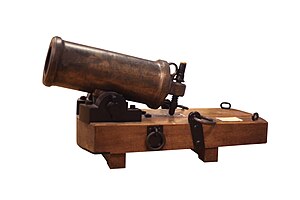| Obusier de vaisseau | |
|---|---|
 Obusier de 36, modèle 1787, found on the wreck of the Golymin. On display at the Musée national de la Marine Obusier de 36, modèle 1787, found on the wreck of the Golymin. On display at the Musée national de la Marine | |
| Type | naval gun |
| Place of origin | France |
| Service history | |
| In service | 1787–1805 |
| Used by | France |
| Production history | |
| Produced | 1787 |
| Specifications | |
| Barrel length | 85 cm |
| Crew | 5 |
| Shell weight | 36 lb (16 kg) |
| Calibre | 36-pounder |
The obusier de vaisseau was a light piece of naval artillery with a large calibre mounted on French warships of the Age of Sail. Designed to fire explosive shells at a low velocity, they were an answer to the carronade in the close combat and anti-personnel role. However, their intended ammunition proved too dangerous for the crew, and the French navy phased them out at the beginning of the Empire in favour of the carronade.
Accounts by British warships of the armament of captured French ships tend to describe them as carronades. However, when the description includes the remark that the weapon was brass, this suggests that it was an obusier.
Several of the guns were recovered from the wreck of the Golymin in the road of Brest, and are now on display at the Musée national de la Marine in Paris and in Brest.
Citations
- Obusier de 36, modèle 1787 ; Obusier de vaisseau, Mobilier de fouille du Golymin, 1814, Musée national de la Marine
References
- Jean Boudriot et Hubert Berti, L'Artillerie de mer : marine française 1650-1850, Paris, éditions Ancre, 1992 (ISBN 2-903179-12-3) (notice BNF no FRBNF355550752). (in French)
- Jean Peter, L'artillerie et les fonderies de la marine sous Louis XIV, Paris, Economica, 1995, 213 p. (ISBN 2-7178-2885-0). (in French)
- Napoléon et l’évolution de l’artillerie des vaisseaux, Nicolas Mioque (in French)
External links
 Media related to Obusier de vaisseau at Wikimedia Commons
Media related to Obusier de vaisseau at Wikimedia Commons
| French naval artillery of 1786 — next » | |
|---|---|
| Long guns | |
| Short guns | |
| Howitzers and Carronades | |